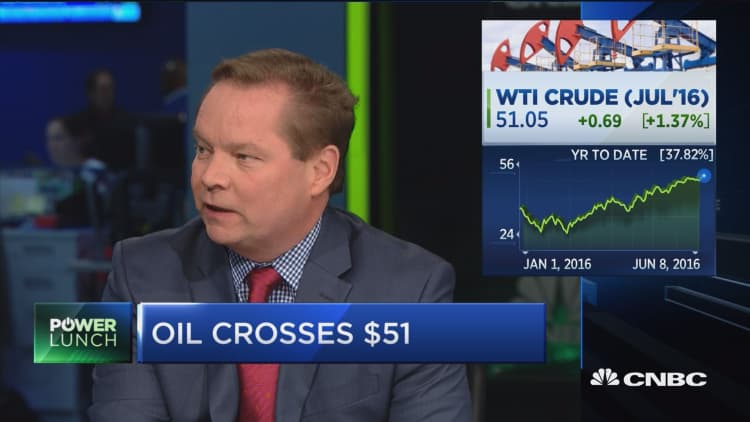


Oil's chart is sizzling, even if its fundamentals are not.
West Texas Intermediate crude futures for July were trading above $51 per barrel for the first time since July 2015. Crude was higher on the weaker dollar, continued supply disruptions and as U.S. government data showed a drawdown in the nation's inventories.
Some of the factors driving the price higher may be fleeting, and oil is widely expected to come off current levels. But strategists say the charts are telling another story.
"This chart defies my own skepticism," said John Kilduff of Again Capital, who has been a crude market bear. He said the chart shows an "inverse head and shoulders" pattern — and a straight line up to where U.S.-traded WTI crude could reach the near-$62 level of last summer.
Kilduff does expect oil to decline, and possibly fall into the $30s after the drop in demand from peak summer driving. A pickup in demand from China may also be temporary, he said.
But still, technically crude looks like it will stay in ascent for the near term.
"The trend is terrific. The chart looks like a million bucks. The chart would say: 'stay long this thing for another $10,'" Kilduff said. But if oil fails at its current level, it would be considered a double top — a very bearish formation.
Crude began to make its latest leg up on a series of production disruptions, from sources ranging from Nigeria to Canada. But analysts have said those disruptions could be temporary, and oil could trade lower when crude returns to the market.
"The market continues to trend higher in a nice channel, and nothing seems to be snapping it out of it," said Gene McGillian, broker and analyst at Tradition Analytics.
"If you look at the channel from $26 up to $50, you would think the fundamental picture has changed significantly," he said. "The fact is, technicals can drive the market for a while, but sooner or later the fundamentals are going to give you your price direction."
Oversupply remains an issue, as Iran pumps more oil into the world market and other nations continue to produce at high levels. OPEC has also done nothing to curb its production but at its meeting last week, Saudi Arabia's new oil minister said the market appears to be balancing and the trend is higher.
McGillian said another risk to prices is an improvement in U.S. economic data, which would put the Fed back on track for an interest rate hike. That would strengthen the dollar, which in turn could hurt crude prices.
Andrew Lipow, president of Lipow Oil Associates, told CNBC that oil could pull back if disruptions come to an end, but he has become more bullish on prices. "As I look out to January 2017, I'm thinking of upping my forecast to $55 a barrel and I think we're just one supply disruption in Venezuela away from hearing about $60 oil because that political environment is very unstable. The electric power situation is unstable, and that could disrupt production," said Lipow.



Another wild card for crude prices is the U.S. oil industry, which has been winding down production after prices collapsed. However, in a sign the market may be balancing, oil production in the U.S. increased just slightly by 10,000 barrels a day, marking the first week-over-week gain in about four months. Crude output was about 8.75 million barrels a day last week, down from 9.6 million barrels at the same time last year.
Some oil producers have said they would begin to return some production when oil hits $50 per barrel. More oil on the market could quickly become a negative.
A recent CNBC oil survey shows a clear divide on the outlook for prices. Half of the analysts, traders and strategists surveyed said they expect WTI crude to trade at $40 to $50 per barrel at the end of 2016, while 45 percent see oil above $50. In the latter group, just 9 percent expect WTI to rise above $60 per barrel.
Fifty percent expect oil prices to move lower after summer driving demand peaks, while 45 percent said they do not believe that will happen. Sixty-four percent, however, do not project a plunge in prices similar to last summer's drop from $60 to $40 per barrel.
Supply remains the biggest risk to prices, according to 32 percent, while geopolitical risk was second at 27 percent. Demand could be the greatest risk, according to 23 percent; 18 percent pointed to fluctuation in the U.S. dollar.
The survey found that most U.S. shale drilling is expected to return when oil rises to $60 or above.


